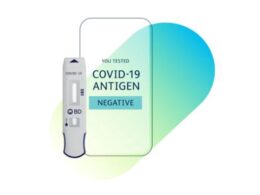New York Times
Aaron E. Carroll
Dr. Carroll is the chief health officer of Indiana University.
January 14, 2022
Credit… Illustration by Shoshana Schultz/The New York Times; photograph by MoMo Productions via Getty Images
Caring for an individual and protecting a population require different priorities, practices and ways of thinking.
While it may sound counterintuitive, to heal the country and put our Covid-19 response on the right track, we need to think less like doctors.
I can speak to both ways of approaching health problems.
As a physician, I was trained first and foremost to think of the individual in front of me. When seeing a patient, I take a long history, consider all relevant personal information and weigh the benefits and harms of any treatment decision I might take.
As the chief health officer of Indiana University, I need to make population-wide decisions that take into account the needs of the university as a whole, not any one person.
Physicians tend to be conservative in their practice of medicine.
We fear a bad outcome disproportionately and will do almost anything to prevent it.
Although doctors often credit the threat of being sued for the practice of defensive medicine, extra tests and procedures are often ordered because making a mistake would be devastating, both to the patient and to our own understanding of ourselves as healers.
This mentality also leads to the thinking that every test and treatment must be the best.
Physicians cannot tolerate anything less, because we are who will be held to account if anything goes wrong.
But blown to the scale of a whole country, that kind of focus on individuals has often led us in the wrong direction during the pandemic.
Much of my frustration at the response to Covid is that too many officials in senior positions at the Food and Drug Administration and the Centers for Disease Control and Prevention seem to be thinking this way — if something isn’t close to perfect or doesn’t maximize the safety of each individual person, it’s not worth it at all.
Some of the greatest initial and continuing failures of public health policy have stemmed from this view.
For example, a focus on doing the “best” for the individual leads to a belief that if you’re going to test people for the coronavirus, the tests used must be of the highest quality, and that’s a professionally collected PCR, even if those tests are harder to perform and supplies are limited.
Focusing on the individual can also lead to excessive fears of bad outcomes, even if they’re rare.
Leaders can come to think that any risk of infections is unacceptable, leading to policies that close schools even though the danger that schools appear to pose is low.
A population-level view, on the other hand, often focuses on reaching as many people as possiblerather than perfection.
This view argues that repeated and regular testing is preferable, and that’s more easily done with tests taken at home even if they’re less sensitive than P.C.R.s in some ways.
That the F.D.A. and the C.D.C. have trouble recognizing the utility of at-home tests as a public health tool, as opposed to purely a clinically diagnostic one, shows the shortfalls of always seeking the best.
More frequent imperfect testing may pick up more cases, even if we miss a few we might have caught with perfect tests. Getting many people to be somewhat safer might achieve more than getting fewer people to be really safe.
More frequent imperfect testing may pick up more cases …
Just this week, my own state, Indiana, made a decision through an individual lens and not a population one.
We are running short on rapid antigen tests at state-run sites.
The state therefore chose not to use them at all for adults ages 19 to 49. Instead, they’re prioritized for those 50 and above as well as children, and patients have to be symptomatic to get a test.
From a clinical lens, this makes sense. You want to save the tests for those at highest risk.
Most younger adults will be fine, while older, sicker people might need more attention.
But from a population lens, this is the absolutely wrong choice.
A test does not prevent you from getting Covid; it gives you the information you need to avoid spreading it.
Young people may be at low risk individually, but they’re a big risk to others because they often go out and interact with people.
Rapid tests are ideal for them.
Masks are another example.
If you can have only the best, you’ll focus on N95 masks, see they are in short supply at the start of the crisis and tell most people they shouldn’t wear masks at all because only certain ones provide the best protection, and we have to save them for those at highest risk.
A population-level view argues that cloth or surgical masks — which aren’t anywhere near as good as N95s but were easier to get — would lower the risk for everyone when the pandemic was beginning, and therefore would be helpful.
It took until April 2020 — many weeks into the pandemic — for the C.D.C. to recommend mask wearing for the general public.
When better masks are more available (as they are now), then of course everyone should be encouraged to use them, even if not everyone will wear one — but the C.D.C. is still sticking to “any mask is better than no mask.” While true, fearing that some individual might not wear any mask if you strongly recommend a better one misses a chance to potentially raise overall safety.
It’s not just doctors who focus on individual risk; it’s also patients.
For example, any parent might reason that the risk to their child from Covid (and other vaccine-preventable diseases) in the United States is very low, so why take on any risk of a vaccine at all?
But from the perspective of the public health system, only with herd immunity, or something close to it, can we begin to see an end to this pandemic — and that requires near-universal vaccination.
Over-focusing on encouraging people to vaccinate to protect themselves, which is what every chart comparing curves of hospitalization among the vaccinated and unvaccinated tries to do, misses opportunities to explain that the biggest reason to vaccinate is often to protect others, especially those who cannot protect themselves.
The response to Covid is just one way this dichotomy expresses itself.
Much of the way medicine discusses screening for diseases in general focuses on the individual.
Diagnosing cancer often feels like failure and leads to an unrelenting push for earlier and earlier detection.
This is how medicine ends up recommending mammograms sooner and more often. If you pull back to the population, you may see that screening mammograms in young, healthy women have done little to reduce their mortality, and much to worry them.
So what can be done about this?
A start would be for those making decisions to explicitly define their goals when deciding what lens to use.
If we’re trying to prevent Covid surges and end the pandemic, then we need to center the population in our thinking.
Health authorities need to get tools like rapid tests and better masks to as many people as possible, especially those who are more likely to spread disease, even if they’re at low risk themselves.
People need to be persuaded or incentivized to vaccinate to protect others.
If you are sick, even with severe Covid, you want someone with a doctor’s viewpoint caring for you.
America, however, is not a patient. And we’d all be better off, as a society and as individuals, if those in control of our country’s health stopped thinking of it that way.
America, however, is not a patient. And we’d all be better off, as a society and as individuals, if those in control of our country’s health stopped thinking of it that way.
Originally published at https://www.nytimes.com on January 14, 2022.
About the author
Bio
Aaron E. Carroll, M.D., M.S. is a Distinguished Professor of Pediatrics and Chief Health Officer at Indiana University.
He is also an Associate Dean for Research Mentoring and the director of the Center for Pediatric and Adolescent Comparative Effectiveness Research at Indiana University School of Medicine.
He earned a B.A. in chemistry from Amherst College, an MD from the University of Pennsylvania School of Medicine, and an M.S. in health services from the University of Washington School of Public Health, where he was also a Robert Wood Johnson Clinical Scholar.
Dr. Carroll’s research focuses on the study of information technology to improve pediatric care, decision analysis, and areas of health policy including cost-effectiveness of care and health care financing reform.
He is the author of The Bad Food Bible and the co-author of three additional books on medical myths. In addition to having been a regular contributor to The New York Times Opinion and the Upshot for more than seven years, he has written for many other major media outlets and is co-Editor-in-Chief at The Incidental Economist, an evidence-based health policy blog. He also has a popular YouTube channel called Healthcare Triage, where he talks about health research and health policy.
Titles & Appointments
- Chief Health Officer, IU
- Associate Dean for Research Mentoring
- Distinguished Professor
- Regenstrief Foundation Professor I
- Professor of Pediatrics
- Director, Center for Health Policy and Professionalism Research
- Vice Chair for Health Outcomes Research Faculty Development
- Director of Surveillance and Mitigation












